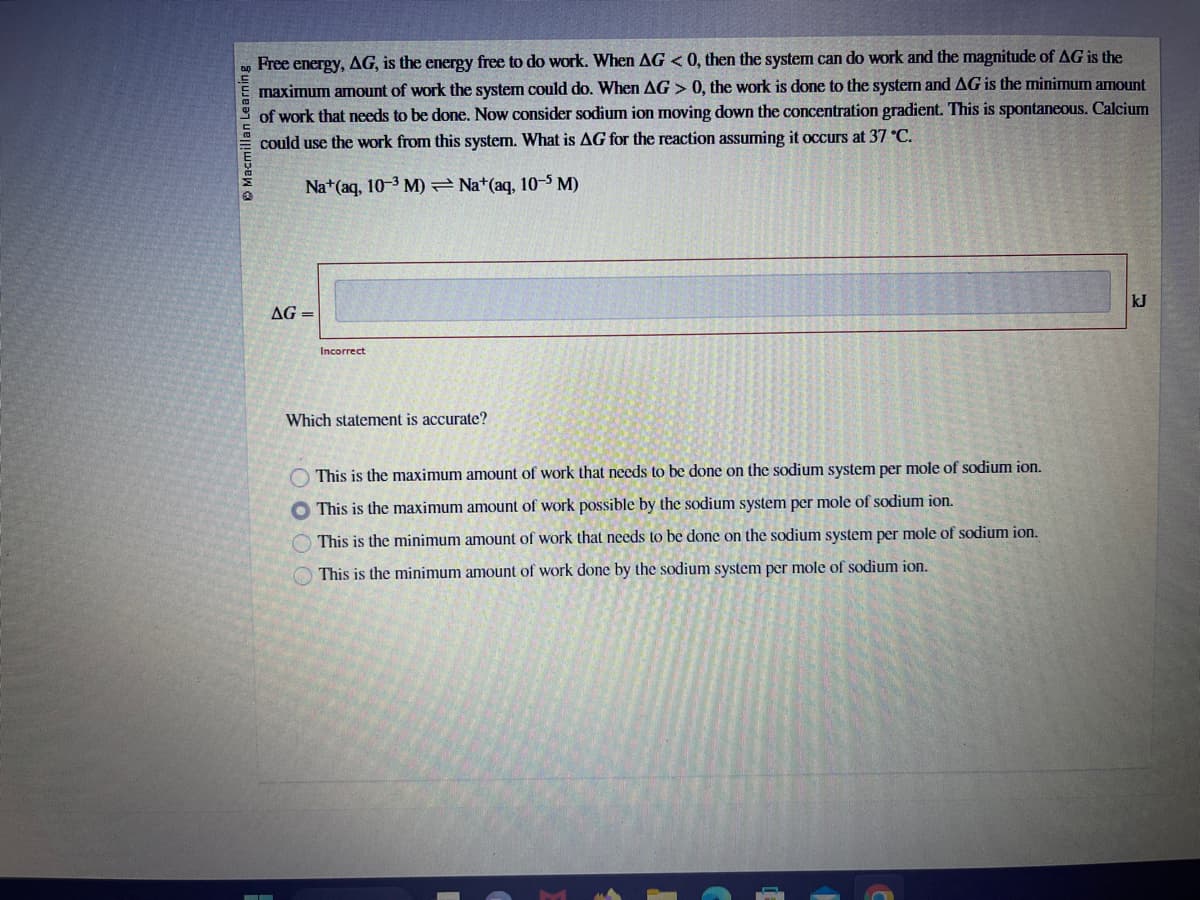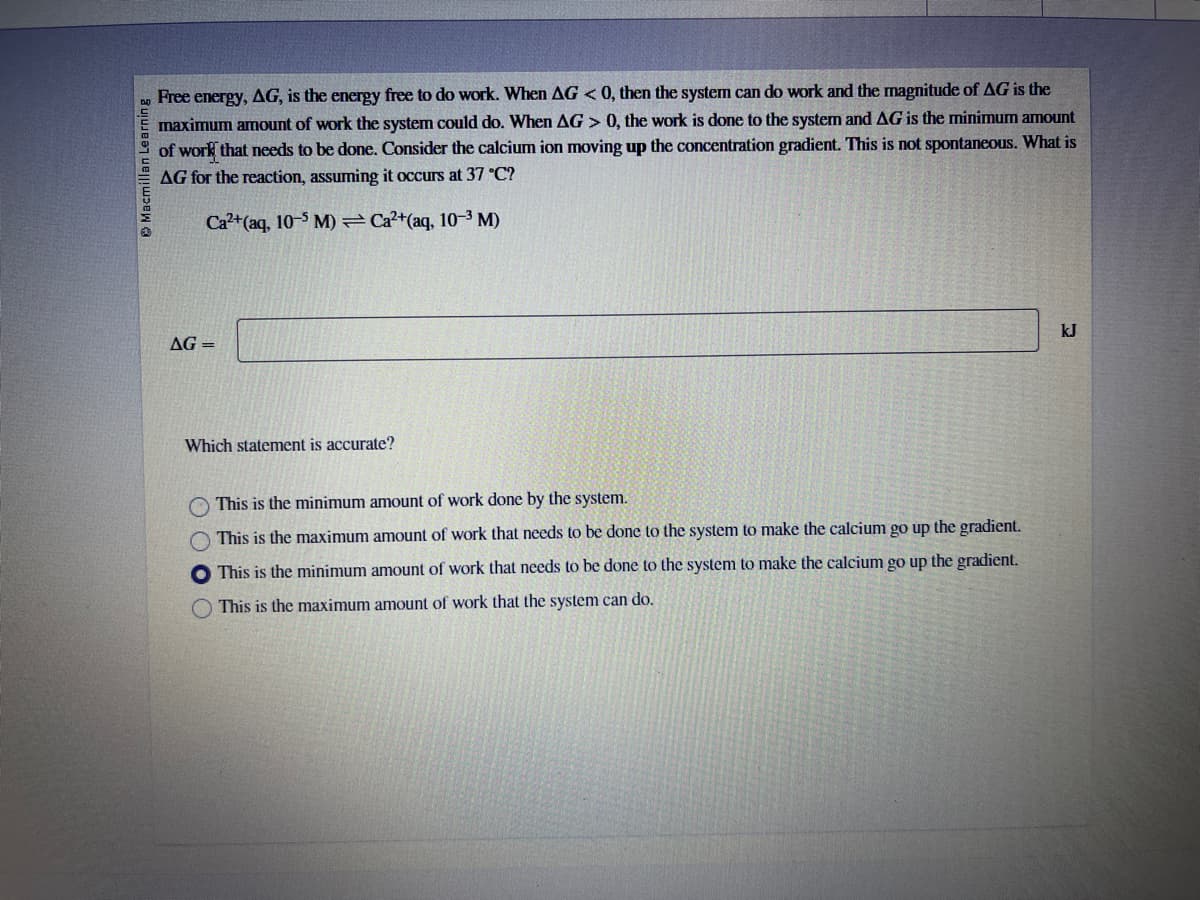-Free energy, AG, is the energy free to do work. When AG < 0, then the system can do work and the magnitude of AG is the maximum amount of work the system could do. When AG > 0, the work is done to the system and AG is the minimum amount E of work that needs to be done. Now consider sodium ion moving down the concentration gradient. This is spontaneous. Calcium could use the work from this system. What is AG for the reaction assuming it occurs at 37 °C. Na+ (aq, 10-3 M) Na+ (aq, 10-5 M) AG= = Incorrect Which statement is accurate? This is the maximum amount of work that needs to be done on the sodium system per mole of sodium ion. O This is the maximum amount of work possible by the sodium system per mole of sodium ion. This is the minimum amount of work that needs to be done on the sodium system per mole of sodium ion. This is the minimum amount of work done by the sodium system per mole of sodium ion. 0 0 0 kJ
-Free energy, AG, is the energy free to do work. When AG < 0, then the system can do work and the magnitude of AG is the maximum amount of work the system could do. When AG > 0, the work is done to the system and AG is the minimum amount E of work that needs to be done. Now consider sodium ion moving down the concentration gradient. This is spontaneous. Calcium could use the work from this system. What is AG for the reaction assuming it occurs at 37 °C. Na+ (aq, 10-3 M) Na+ (aq, 10-5 M) AG= = Incorrect Which statement is accurate? This is the maximum amount of work that needs to be done on the sodium system per mole of sodium ion. O This is the maximum amount of work possible by the sodium system per mole of sodium ion. This is the minimum amount of work that needs to be done on the sodium system per mole of sodium ion. This is the minimum amount of work done by the sodium system per mole of sodium ion. 0 0 0 kJ
Chemistry
10th Edition
ISBN:9781305957404
Author:Steven S. Zumdahl, Susan A. Zumdahl, Donald J. DeCoste
Publisher:Steven S. Zumdahl, Susan A. Zumdahl, Donald J. DeCoste
Chapter17: Spontaneity, Entropy, And Free Energy
Section: Chapter Questions
Problem 27Q: Consider the reaction N2O2(g) 2NO2(g) where PNO2=0.29 atm and PN2O4=1.6. For this reaction at these...
Related questions
Question
How can we find the solutions?

Transcribed Image Text:Macmillan Learning
Free energy, AG, is the energy free to do work. When AG < 0, then the system can do work and the magnitude of AG is the
maximum amount of work the system could do. When AG > 0, the work is done to the system and AG is the minimum amount
of work that needs to be done. Now consider sodium ion moving down the concentration gradient. This is spontaneous. Calcium
could use the work from this system. What is AG for the reaction assuming it occurs at 37 °C.
Na+ (aq, 10-3 M)
Na+(aq, 10-5 M)
AG=
Incorrect
Which statement is accurate?
This is the maximum amount of work that needs to be done on the sodium system per mole of sodium ion.
This is the maximum amount of work possible by the sodium system per mole of sodium ion.
This is the minimum amount of work that needs to be done on the sodium system per mole of sodium ion.
This is the minimum amount of work done by the sodium system per mole of sodium ion.
kJ

Transcribed Image Text:Macmillan Learning
Free energy, AG, is the energy free to do work. When AG < 0, then the system can do work and the magnitude of AG is the
maximum amount of work the system could do. When AG > 0, the work is done to the system and AG is the minimum amount
of work that needs to be done. Consider the calcium ion moving up the concentration gradient. This is not spontaneous. What is
AG for the reaction, assuming it occurs at 37 °C?
Ca²+ (aq, 10-5 M)=Ca²+(aq, 10-³ M)
AG=
Which statement is accurate?
This is the minimum amount of work done by the system.
This is the maximum amount of work that needs to be done to the system to make the calcium go up the gradient.
This is the minimum amount of work that needs to be done to the system to make the calcium go up the gradient.
This is the maximum amount of work that the system can do.
kJ
Expert Solution
This question has been solved!
Explore an expertly crafted, step-by-step solution for a thorough understanding of key concepts.
This is a popular solution!
Trending now
This is a popular solution!
Step by step
Solved in 2 steps with 2 images

Knowledge Booster
Learn more about
Need a deep-dive on the concept behind this application? Look no further. Learn more about this topic, chemistry and related others by exploring similar questions and additional content below.Recommended textbooks for you

Chemistry
Chemistry
ISBN:
9781305957404
Author:
Steven S. Zumdahl, Susan A. Zumdahl, Donald J. DeCoste
Publisher:
Cengage Learning

Chemistry for Engineering Students
Chemistry
ISBN:
9781337398909
Author:
Lawrence S. Brown, Tom Holme
Publisher:
Cengage Learning

General Chemistry - Standalone book (MindTap Cour…
Chemistry
ISBN:
9781305580343
Author:
Steven D. Gammon, Ebbing, Darrell Ebbing, Steven D., Darrell; Gammon, Darrell Ebbing; Steven D. Gammon, Darrell D.; Gammon, Ebbing; Steven D. Gammon; Darrell
Publisher:
Cengage Learning

Chemistry
Chemistry
ISBN:
9781305957404
Author:
Steven S. Zumdahl, Susan A. Zumdahl, Donald J. DeCoste
Publisher:
Cengage Learning

Chemistry for Engineering Students
Chemistry
ISBN:
9781337398909
Author:
Lawrence S. Brown, Tom Holme
Publisher:
Cengage Learning

General Chemistry - Standalone book (MindTap Cour…
Chemistry
ISBN:
9781305580343
Author:
Steven D. Gammon, Ebbing, Darrell Ebbing, Steven D., Darrell; Gammon, Darrell Ebbing; Steven D. Gammon, Darrell D.; Gammon, Ebbing; Steven D. Gammon; Darrell
Publisher:
Cengage Learning

Chemistry: An Atoms First Approach
Chemistry
ISBN:
9781305079243
Author:
Steven S. Zumdahl, Susan A. Zumdahl
Publisher:
Cengage Learning


Chemistry: Principles and Practice
Chemistry
ISBN:
9780534420123
Author:
Daniel L. Reger, Scott R. Goode, David W. Ball, Edward Mercer
Publisher:
Cengage Learning